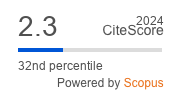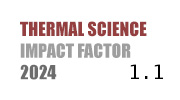THERMAL SCIENCE
International Scientific Journal
Thermal Science - Online First
online first only
Study on multiple mechanisms and contribution weights of slagging in biomass-fired boiler
ABSTRACT
To address the serious slagging issue in biomass boilers, field sampling, compositional analysis and corresponding FactSage thermodynamic calculations were conducted to study the slagging characteristics of a straw/bark-fired grate boiler. In addition to clarifying the multiple mechanisms, including the initial deposition by gaseous condensation and the fly ash capture by the viscous initial layer, the contribution weights of various mechanisms to the slagging behavior in four superheater areas were also obtained. Results indicate that K/Na double sulfates, rather than regular alkali sulfates, play a key role in forming the initial layer by condensation in high-temperature superheater. In 2nd mid-temperature superheater, the condensed KCl and less sulfate form high-viscosity initial layer, which captures fly ash easily and results in serious slagging. The composition evolution during slagging process simulated by FactSage indicates that low-temperature eutectics formed at high temperature area are more easily captured by the initial layer of high temperature superheater. The sulfates of K and Na start to combine below 950ºC and completely form K3Na(SO4)2 at 750ºC. K-Ca double sulfates exist above 850ºC, while below 750ºC completely decompose into K2SO4 and CaSO4. The gaseous condensation deposition contributes over 45% in the slagging of high/mid-temperature superheater, and only 8.4% in low-temperature superheater. The results provide a basis for the slagging prediction and prevention in biomass-fired grate boiler.
KEYWORDS
PAPER SUBMITTED: 2025-03-28
PAPER REVISED: 2025-05-21
PAPER ACCEPTED: 2025-06-02
PUBLISHED ONLINE: 2025-08-02
- Mikuli, H., et al., Flexible Carbon Capture and Utilization technologies in future energy systems and the utilization pathways of captured CO2, Renewable and Sustainable Energy Reviews, 114(2019), 109338
- Zhao, X., et al., Challenges toward carbon neutrality in China: Strategies and countermeasures, Resources, Conservation and Recycling, 176(2022), 105959
- Wang, J., et al., Does renewable energy technological innovation matter for green total factor productivity? Empirical evidence from Chinese provinces, Sustain Energy Technol Assess, 55(2023), 102996
- Ostergaard, P. A.,et al., Advances in renewable energy for sustainable development, Renewable energy, 219(2023), 119377
- Manzano-Agugliaro, F., et al., Scientific production of renewable energies worldwide: An overview, Renewable & Sustainable Energy Reviews, 18(2013), pp. 134-143
- Yin, C, Li S., Advancing grate-firing for greater environmental impacts and efficiency for decentralized biomass/wastes combustion, Energy Procedia, 120(2017), pp. 373-379
- Niu, Y., et al., Ash-related issues during biomass combustion: Alkali-induced slagging, silicate melt-induced slagging (ash fusion), agglomeration, corrosion, ash utilization, and related countermeasures, Progress in Energy & Combustionence, 52(2016), pp. 1-61
- Niu, Y., et al., Slagging Characteristics on the Superheaters of a 12 MW Biomass-Fired Boiler, Energy Fuels, 24(2010), pp. 5222-5227
- Khalil, R. A., et al., Experimental Investigation on Corrosion Abatement in Straw Combustion by Fuel Mixing, Energy & Fuels, 26(2014), 6, pp. 2687-2695
- Kleinhans, U., et al., Ash formation and deposition in coal and biomass fired combustion systems: Progress and challenges in the field of ash particle sticking and rebound behavior, Progress in Energy and Combustion Science, 68(2018), pp. 65-168
- Yongtie, C., et al., Modeling of ash formation and deposition processes in coal and biomass fired boilers: A comprehensive review, Applied Energy, 230(2018), pp. 1447-1544
- Wei, X., et al., Behaviour of gaseous chlorine and alkali metals during biomass thermal utilisation, Fuel, 84(2005), 7/8, pp. 841-848
- Johansen, J. M., et al., Release of K, Cl, and S during Pyrolysis and Combustion of High-Chlorine Biomass, Energy & Fuels, 25(2011), 11, pp. 4961-4971
- Wang, Z., et al., Alkali metal release in thermochemical conversion of biomass and coal: Optical measurements and modeling, Progress in energy and combustion science, 100(2024), 101131
- Yu, S., et al., Investigation on the influence of sulfur and chlorine on the initial deposition/fouling characteristics of a high-alkali coal, Fuel Processing Technology, 198(2020), 106234
- Garba, M. U., et al., Prediction of Potassium Chloride Sulfation and Its Effect on Deposition in Biomass-Fired Boilers, Energy & Fuels, 26(2012), 11, pp. 6501-6508
- Johansson, L. S., et al., Properties of Particles in the Fly Ash of a Biofuel-Fired Circulating Fluidized Bed (CFB) Boiler, Energy & Fuels, 22(2008), 5, pp. 3005-3015
- Zhu, Y. M., et al., Slagging characteristics in the superheater area and K/Ca distribution of biomass-fired grate boiler, Sustainable Energy Technologies and Assessment, 59(2023), 103403
- Hu, Z., et al., Emission characteristics of particulate matters from a 30 MW biomass-fired power plant in China, Renewable Energy, 155(2020), pp. 225-236
- Li, L., et al., Study on the Deposits Derived from a Biomass Circulating Fluidized-Bed Boiler, Energy & Fuels, 26(2012), 9, pp. 6008-6014
- Nutalapati, D., et al., Assessing slagging and fouling during biomass combustion: A thermodynamic approach allowing for alkali/ash reactions, Fuel Processing Technology, 88(2007), 11-12, pp. 1044-1052
- Wang, G., et al., Investigation on ash deposit formation during the co-firing of coal with agricultural residues in a large-scale laboratory furnace, Fuel, 117(2014), pp. 269-277
- Wang, Y., et al., Numerical investigation on deposition rate of mechanically mixed ash particles in an entrained flow reactor, Asia-Pacific Journal of Chemical Engineering, 16(2021), 5, e2685
- Jia, T., et al., Characteristics and mechanism of slagging in a 500t/d MSW incinerator, Journal of the Energy Institute, 114(2024), 101585
- Tang, Z., et al., Experimental investigation of ash deposits on convection heating surfaces of a circulating fluidized bed municipal solid waste incinerator, Journal of Environmental Science, 48(2016), pp. 169-178
- Öhman, M., Nordin, A., Bed Agglomeration Characteristics during Fluidized Bed Combustion of Biomass Fuels, Renewable Energy Resources, 26(2007), 1, pp. 4550-4559
- Wei, B., et al., Investigation of characteristics and formation mechanisms of deposits on different positions in full-scale boiler burning high alkali coal, Applied Thermal Engineering, 119(2017), 119, pp. 449-458
- Wang, Y., et al., Understanding ash deposition for Zhundong coal combustion in 330 MW utility boiler: Focusing on surface temperature effects, Fuel, 216(2018), pp. 697-706
- Niu, Y., et al., Further study on biomass ash characteristics at elevated ashing temperatures: The evolution of K, Cl, S and the ash fusion characteristic, Bioresource Technology, 129(2013), pp. 642-645
- Kassman, H., et al., The importance of SO2 and SO3 for sulphation of gaseous KCl - An experimental investigation in a biomass fired CFB boiler, Combustion & Flame, 157(2010), 9, pp. 1649-1657
- Chanpirak, A., et al., Sulfation of Gaseous KCl by H2SO4, Energy & Fuels, 37(2023), 3, pp. 2319-2328
- Zhang, H., et al., Investigation of Ash Deposition Dynamic Process in an Industrial Biomass CFB Boiler Burning High-Alkali and Low-Chlorine Fuel, RSC advances, 10(2020), 36, pp. 21420-21426
- Enders, M., et al., Temperature-Dependent Fractionation of Particulate Matter and Sulfates from a Hot Flue Gas in Pressurized Pulverized Coal Combustion (PPCC), Energy & Fuels, 14(2000), 4, pp. 806-815

